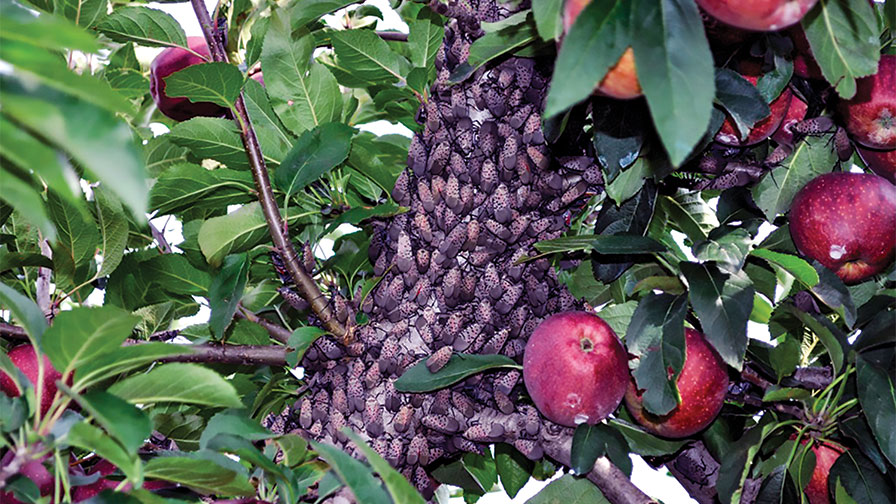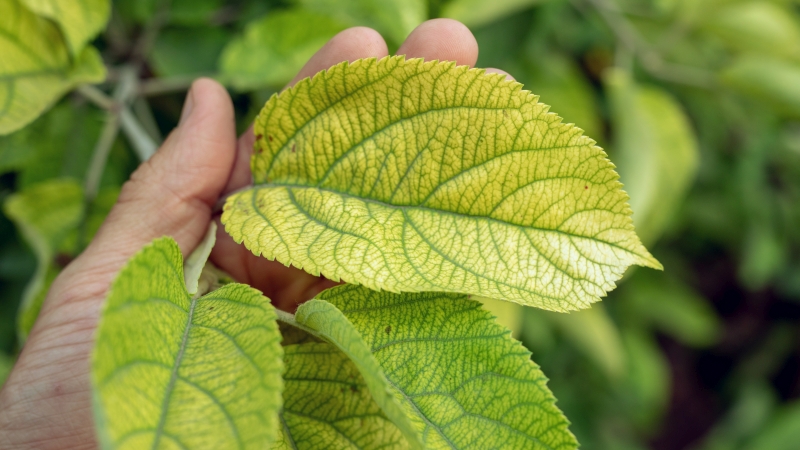New Finds of Spotted Lanternfly on Apple

Spotted lanternfly on apple in Berks County, PA, in October 2017. (Photo: Erica Smyers, Penn State University)
Pennsylvania growers are no stranger to spotted lanternfly (SLF) – a sap-feeding planthopper native to Asia. The quarantine has been expanding and it has now been found in four other states: Virginia, New Jersey, New York, and Delaware.
The pest has still proven to be somewhat of an enigma. Population numbers have continued to increase inside the quarantine zone. But its feeding patterns have been uncharacteristic of its habits in Asia. As an invasive species in Korea, it is known to attack 67 host species — including grapes, apples, and stone fruit.
“According to the Korean literature, it should have died from the cold a couple of winters ago, so obviously we can’t completely rely on what happened in Korea,” says David Biddinger a Tree Fruit Entomologist with Penn State University.
One thing that has been the same is its voracious appetite for tree of heaven. There have been many reports of spotted lanternflies feeding on grape vines.
That all changed in September 2017, when spotted lanternfly was found feeding on apple trees in commercial orchards. This is the first report of lanternfly in a commercial orchard.
While this behavior is new for spotted lanternfly, researchers are encouraging growers to scout, since this will be the first season with the possibility of a spotted lanternfly invasion. And, adults feed on the phloem of the trees and secret their calling-card honeydew, which could be a cause for concern for tree fruit growers.
Finds in Apple
“The way I sometimes think about this insect is that it is a strange combination of periodical cicada and pear psylla: they feed only on wood but not directly on fruit (as periodical cicada) but release huge volume of honeydew (as pear psylla) which may potentially affect fruit as well,” says Greg Krawczyk, a Penn State University Extension Tree Fruit Entomologist.
Krawczyk says this honeydew is a source of development for sooty mold on the leaves of ornamental trees. Trees with heavy infestation experience diebacks. But, he says so far there have not been any reports on fruit trees. It’s early in the process to speculate, but it is something growers should keep in mind.
“We did not see any SLF until fall, when adults started to migrate from woods into orchards. Growers in affected areas reported being able to find SLF egg masses during the winter on nectarine and apple trees,” he says.
Biddinger says immediate damage to the fruit was not observed, but the egg masses found do put the trees at risk for more damage from nymphs and adults this year. As far as last year’s find, the numbers were high and were similar to the outbreak e 17-year cicada.
However, this case of spotted lanternfly in apples was likely temporary.
“While the adult SLF were feeding on apple, the movement through the orchards was transitory and did not last a full week,” he says. “They were probably moving to the vineyard downwind and as they are normally poor fliers, were climbing to the top of apple trees, feeding for a short period and then jumping off from this higher vantage point to catch the thermals on this hot day [in September], to fly further down wind.”
Sven-Erik Spichiger, Entomology Program Manager at the Pennsylvania Department of Agriculture, also says generally larger trees seemed to be favored by SLF.
What Can Be Done?
For now, it’s important to understand the risk this pest could have to your trees. Egg masses can be found on all sorts of objects, as the pest is quite a hitchhiker.
“The research also indicates that the pest is able to travel up to five kilometers per year, so an orchard can be at risk even if no preferred host is on the property,” Spichiger says.
Look for egg masses from September to June, he advises. Damage is visible from July to December.
Spichiger says it is vital to take the time to train your employees to recognize and detect the insect, nymphs, and egg masses.
“Ensure that equipment, visitors, and products brought to the orchard are free of the pest. Consider having a management plan prepared to deal with the pest should it be introduced,” he says. “If introduced SLF could be present from late April through the first hard frost.”
It also goes without saying that removing SLF’s No. 1 host, the tree of heaven, from near your orchard vicinity can also help mitigate your risk. Report all findings to your local Extension personnel, too, as they track SLF’s behavior and infestations.
Focus on Early Detection
“SLF likes to feed on tree of heaven and if that tree species is present in woods surrounding orchards, it represents the best early detection tool if SLF is in the area,” Krawczyk says. “It is very unlikely to have established SLF populations in commercial orchards before it will be established in the surrounding woods, especially with all the management activities directed against other pests.”
Krawczyk says the research team at Penn State is evaluating the efficacy of insecticides against SLF instars. This year is the first for SLF research in fruit orchards, he says.
“The big question all of us have is what will be the practical impact of SLF nymph and adult feeding on the growth and health of fruit trees and grapes. At the moment, most answers we have are just speculative or based on anecdotal observations,” he says. “But we are gearing to get the answers as fast as we can.”










